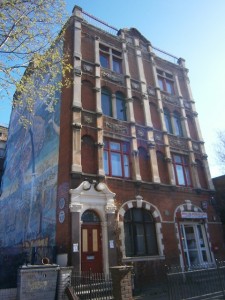
By Zoe Jewell, editor
On one side of Coldharbour Lane, outside Granville Arcade, a couple are standing and taking a photo. The building they are interested in is a majestic Victorian mansion block, built in 1891 and especially noticeable because it stands alone, with a fading glamour, the railway on one side and the eighties Southwyck House on the other. In that building live the residents of the Carlton Mansions Housing Co-operative, now threatened with eviction after thirty-two years. Many are professional artists; others work in jobs ranging from retail to community activism. The members have impacted Brixton in unquantifiable ways; voracious in their love for living here, they are well known at community meetings, get involved in council consultations, protect Brixton’s murals and are an integral part of what now ‘sells’ Brixton – its diversity, its artistic streak, its political history. With their existence under threat, we talk to some of the current residents
Madeleine
Madeleine’s flat is filled with beautifully coloured glass – she is an artist who makes lights and chandeliers out of reclaimed materials. She came to London in the 1970s aged 18 to study art, champing at the bit to get to the city and fascinated by the punk scene here.
Madeleine was at Goldsmiths at the same time as Damien Hirst. “I used to bump into him because he lived in the Barrier Block for a short period.” She is very much inspired by the Brixton environment and had her first exhibition here in 1994 in a space on Acre Lane. “I find materials here and in the market. It’s a fantastic, stimulating place to live.” Her work has been sold everywhere, featuring in the British Council collection, galleries in Tokyo and even Penhaligon’s Perfumers. “I don’t want my work to scream ‘I’m a load of old things’ at you – very often people don’t realize what the components are at first glance, they just see a chandelier.”
Madeleine, pictured above, has loved living in a co-operative. This particular one, it is clear, is built on solid foundations – no tales here of squabbling that one might sometimes find in a co-op. “Here we really do look after each other, because we’re a co-op which has had to work together and we know each other from having meetings together.” When one member – Julian Wall – fell ill years ago, people painted and carpeted his flat when he was in hospital so that when he came home it was more comfortable. His memorial plaque is now on the front of the building.
The co-operative model has recently been much praised for being a clever solution to recession poverty. Madeleine agrees with that. “It works so much better than a lot of other things. It’s so economical in many ways. Other people are living where they’re paying management agencies and really a lot of the money is not going for the work, it’s going for the bureaucracy of that system. We’ve got a history of self-build.”
“The whole reuse thing and being economical was a lifestyle. It was pure common sense. My work grew out of a lifestyle of reuse and wanting to be a bit ingenious with old objects.”
“To destroy us would be absolutely ridiculous and heartbreaking. When you hear all these things like ‘cooperative council’, ‘big society’ and all that kind of stuff, you think: “guys, you don’t know a thing, you’re about to destroy us and we’ve been doing this for years!”
Sara
“When it rains, it pours” is perhaps apt when describing Sara’s current situation. She has spent the past week reeling from the news that the council want her and her neighbours leave their homes. But as an artist at the Stockwell Studios, she is also about to be evicted from there too, after Lambeth Council sold the arts centre to a private housing developer last year.
Her work is currently being shown at the Jerwood space and was also exhibited in the 2012 V22 Young London collection, which showcases emerging artists. “My work usually appropriates the context in which it happens, in a sculptural way. It makes something new, it doesn’t just comment on the context.” It is only by having both an affordable studio and flat that Sara has been able to dedicate herself to making art, working part time to subsidise that.
Sara is Portugese and for her “Brixton is my home now, not my hometown, and I think that’s quite significant. I go to the coffee shops down Atlantic Rd and they know my name, they ask about my mum who came to visit once”.
She talks warmly of the co-op. “I think it’s the fact that you’re actively responsible for the place where you live. We have our own private spaces but there’s an invisible side of it where we are responsible for each other and it’s alright, it’s not a burden, it makes it easier.”
Ruth
For a period of my childhood, I walked past the Big Splash mural on Glenelg Rd almost every day. It denoted a completely different world right in the middle of urban Brixton; it was somehow magical. It was only years later, in 2011, that I found out the story behind that mural – who created it and why it was there – as well as many more in Brixton, when Ruth took me on a tour of the area.
Ruth has featured on these pages many, many times – first as the founder of the London Mural Preservation Society (LMPS) and then as the author of the Little Lambeth blog and the Little Brixton column. It is somehow apt that she is a resident of Carlton Mansions, which hosts the legendary Nuclear Dawn mural on one side of the building. One of the artists who painted the mural lived here. “It’s the politics and thinking of the time – it’s old Brixton, that’s just the way it was, and that politics is on the side of the wall there and that’s where co-op ideas come from too.”
The sense of history really pleases her. Having just had a baby (see pic, below), Ruth has even looked back at the census and found that right at the beginning of the building’s history there was somebody born in the flat she now lives in. “It’s interesting because there are still quite a lot of bits of it which belong to the original building – where my fireplace is you can see where there would have been something sitting there to do your cooking on. It really is part of Brixton’s old building stock and it would be really sad to see it go. Internally, I can’t see any real problems with it.” It would be a great shame, she says, to see the interiors knocked down and only the frontage left.
Ruth takes me up to the roof – it’s like being on the set of Mary Poppins, a view of Brixton I have never seen before.
“I enjoy the experience of living in a co-op. I enjoy having a personal private space but also being part of something. The members of the co-op have an interest in making things better here.”
Ruth works alongside the volunteer projects she runs. “Both projects have benefitted people in the local community. I’ve had verbal feedback so it’s not just doing something for myself.”
Anthony
‘Short Life is Great” is the title of Anthony’s latest art work, a video documentary of his flat at Carlton Mansions. “The title is a joke. It’s definitely great because, you know, it helps me to work, because my funds are very small and to be able to have an affordable house helps a good deal. Also I think it (Carlton Mansions) has this ‘off the track’ interior. I like the drafts, it’s not a confined environment.”
Anthony has often used the subject of ‘shortlife’ in his artworks. “It could be ‘short life’ as it is, as time flies, but it’s also to do with the situation where I live. I have documented Carlton Mansions – I use disused materials like doors and instead of chucking them away from the co-op I’ve used them to hang my work on it, speakers or monitors or framed pictures.”
Anthony made “Short Life is Great” and another piece, “Short Life in Detail” (see pic, below), around the same time as the consultations on Somerleyton Rd got underway. “I did it in an optimistic place. We were participating and brainstorming with the council on the Somerleyton Rd redevelopment project. So the level of optimism in those pieces could come from this situation. But then it got bad, of course, and my thinking about this piece started taking a different sort of energy and maybe it became more ironic.”
Anthony has just won a fellowship to the Jerwood artspace.

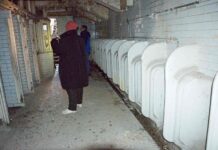
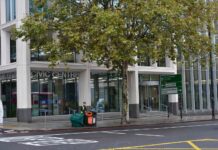

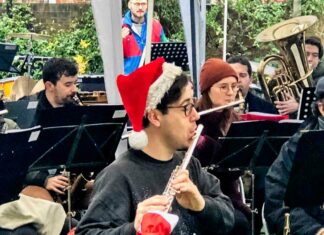




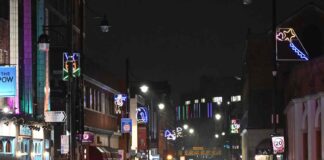








New Labour – the price of everything and the value of nothing. The block is a prime piece of real estate, ripe for development and sale. It doesn’t matter that people who live here will be kicked out and their contribution to their community eradicated. With New Labour Councillors willing to do their dirty work for them, Brixton doesn’t need Tories in the Town Hall.
not much explantion why
It is fairly obvious, surely? A prime location in zone 2 trendy, happening gentrified Brixton. Once the residents have been booted out the place will be tarted up, the new ‘luxury flats’ will be advertised in smart, swishy Foxton’s windows and then flogged to yuppies for over half a million quid a piece. Loadsa money for the council, lovely new pads for the hipsters within a stone’s throw of the ‘vintage’ ‘retro’ market and the fab new foodie outlets. Everyone’s a winner, darling! With any luck there’ll be a Fortnum and Masons in Market Row soon enough. Come on and get with the agenda, sweetie!
Short term the building failed a fire inspection, medium-term it will be part of the Somerleytown redevelopment.
http://www.brixtongreen.org/